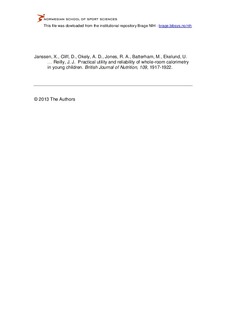| dc.contributor.author | Janssen, Xanne | |
| dc.contributor.author | Cliff, Dylan | |
| dc.contributor.author | Okely, Anthony D. | |
| dc.contributor.author | Jones, Rachel A. | |
| dc.contributor.author | Batterham, Marijka | |
| dc.contributor.author | Ekelund, Ulf | |
| dc.contributor.author | Brage, Søren | |
| dc.contributor.author | Reilly, John J. | |
| dc.date.accessioned | 2013-10-07T09:17:52Z | |
| dc.date.available | 2013-10-07T09:17:52Z | |
| dc.date.issued | 2012-09-19 | |
| dc.identifier | Seksjon for idrettsmedisinske fag / Department of Sports Medicine | |
| dc.identifier.citation | British journal of nutrition. 2013, 109(10), 1719-1922 | no_NO |
| dc.identifier.uri | http://hdl.handle.net/11250/171200 | |
| dc.description | © 2013 The Authors | no_NO |
| dc.description.abstract | The use of whole-room calorimetry (WRC) in young children can increase our understanding of children's energy balance. However, studies using WRC in young children are rare due to concerns about its feasibility. To assess the feasibility of WRC in young children, forty children, aged 4–6 years, were asked to follow a graded activity protocol while in a WRC. In addition, six children participated in two additional resting protocols to examine the effect of diet-induced thermogenesis on resting energy expenditure (REE) measures and the reliability of REE measurement. Refusals to participate and data loss were quantified as measures of practical utility, and REE measured after an overnight fast and after a 90-min fast were compared. In addition, both were compared to predicted BMR values using the Schofield equation. Our results showed that thirty (78·9 %) participants had acceptable data for all intensities of the activity protocol. The REE values measured after a 90-min fast (5·07 (sd 1·04) MJ/d) and an overnight fast (4·73 (sd 0·61) MJ/d) were not significantly different from each other (P= 0·472). However, both REE after an overnight fast and a 90-min fast were significantly higher than predicted BMR (3·96 (sd 0·18) MJ/d) using the Schofield equation (P= 0·024 and 0·042, respectively). We conclude that, with a developmentally sensitive approach, WRC is feasible and can be standardised adequately even in 4- to 6-year-old children. In addition, the effect of a small standardised breakfast, approximately 90 min before REE measurements, is likely to be small. | no_NO |
| dc.language.iso | eng | no_NO |
| dc.publisher | Cambridge University Press | no_NO |
| dc.subject | activity energy expenditure | no_NO |
| dc.subject | energy metabolism | no_NO |
| dc.subject | pre-school children | no_NO |
| dc.subject | resting energy expenditure | no_NO |
| dc.title | Practical utility and reliability of whole-room calorimetry in young children | no_NO |
| dc.type | Journal article | no_NO |
| dc.type | Peer reviewed | no_NO |
| dc.subject.nsi | VDP::Mathematics and natural science: 400::Basic biosciences: 470 | no_NO |
| dc.subject.nsi | VDP::Medical disciplines: 700::Basic medical, dental and veterinary science disciplines: 710 | no_NO |
| dc.subject.nsi | VDP::Medical disciplines: 700::Clinical medical disciplines: 750 | no_NO |
| dc.subject.nsi | VDP::Medical disciplines: 700::Health sciences: 800 | no_NO |
| dc.identifier.doi | 10.1017/S0007114512003820 | |
